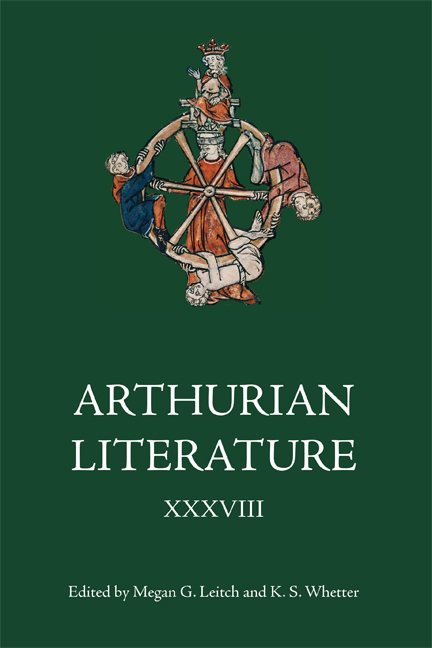Book contents
- Frontmatter
- Contents
- List of Figures and Tables
- Note on the Derek Brewer Prize
- General Editors’ Preface
- List of Contributors
- List of Abbreviations
- 1 The Inaugural Derek Brewer Essay Prize: Animals at the Feast: Strange Strangers and Courtly Power in The Wedding of Sir Gawain and Dame Ragnelle
- 2 The Kindred of a Boy without a Father: Merlin’s British Forebears and Irish Cousins
- 3 Geoffrey of Monmouth’s Subtle Subversion: Active Double- Voiced Discourse in the Historia regum Britanniae
- 4 ‘Cornwall, up in the North’: Geography and Place Names in the Source of the Old Icelandic Brut
- 5 Enacting Arthurianism in the Order of the Garter and Sir Gawain and the Green Knight
- 6 Deviants and Dissenters: Theorizing Shame and Punishment in Malory’s Morte
- 7 Loyalty and Worshyp in Conflict in Malory’s Lancelot
- 8 Emotional Inheritance in Malory’s Morte Darthur: Shame and the Lott–Pellinore Feud
- 9 Navigating and Indexing Arthurian Romance in Benoît Rigaud’s Edition of Lancelot du Lake (1591)
- 10 ‘A great many strange puppets’: Queen Caroline, Merlin’s Cave, and Symbolic Arthurianism in the Age of Reason
- 11 How Galahad Regained his Virginity: Dead Women, Catholicism and the Grail in Nineteenth-Century British Poetry
- Notes
- Miscellaneous Endmatter
1 - The Inaugural Derek Brewer Essay Prize: Animals at the Feast: Strange Strangers and Courtly Power in The Wedding of Sir Gawain and Dame Ragnelle
Published online by Cambridge University Press: 10 January 2024
- Frontmatter
- Contents
- List of Figures and Tables
- Note on the Derek Brewer Prize
- General Editors’ Preface
- List of Contributors
- List of Abbreviations
- 1 The Inaugural Derek Brewer Essay Prize: Animals at the Feast: Strange Strangers and Courtly Power in The Wedding of Sir Gawain and Dame Ragnelle
- 2 The Kindred of a Boy without a Father: Merlin’s British Forebears and Irish Cousins
- 3 Geoffrey of Monmouth’s Subtle Subversion: Active Double- Voiced Discourse in the Historia regum Britanniae
- 4 ‘Cornwall, up in the North’: Geography and Place Names in the Source of the Old Icelandic Brut
- 5 Enacting Arthurianism in the Order of the Garter and Sir Gawain and the Green Knight
- 6 Deviants and Dissenters: Theorizing Shame and Punishment in Malory’s Morte
- 7 Loyalty and Worshyp in Conflict in Malory’s Lancelot
- 8 Emotional Inheritance in Malory’s Morte Darthur: Shame and the Lott–Pellinore Feud
- 9 Navigating and Indexing Arthurian Romance in Benoît Rigaud’s Edition of Lancelot du Lake (1591)
- 10 ‘A great many strange puppets’: Queen Caroline, Merlin’s Cave, and Symbolic Arthurianism in the Age of Reason
- 11 How Galahad Regained his Virginity: Dead Women, Catholicism and the Grail in Nineteenth-Century British Poetry
- Notes
- Miscellaneous Endmatter
Summary
The one tusk went vp, and the other doun;
A mowthe fulle wyde, and fowlle igrown.
With grey herys many on;
Her lyppes laye lumpryd on her chyn;
Nek forsothe on her was none i-seen, —
She was a lothly on!
The mesh is vast yet intimate: there is no here or there, so everything is brought within our awareness. The more we analyze, the more ambiguous things become. We can't really know who is at the junctions of the mesh before we meet them. Even when we meet them, they are liable to change before our eyes, and our view of them is also labile. These beings are the strange stranger.
Dame Ragnelle in The Wedding of Sir Gawain and Dame Ragnelle is difficult to define. She is human, in that she rides a horse, wears a dress, and is to marry Gawain, but she has distinctly animal-like features, boar-like tusks and bristles, which sit alongside grotesque but human characteristics. She is not a hybrid, comprised of two separate parts like a faun, nor does she metamorphosize between wholly animal and wholly human like a werewolf. Instead, before her final transformation into a beautiful maiden, she is a mixture of both. Her presence is frightening and alarming for the Arthurian court, but attempts to isolate her only expose the strangeness already within the court. Despite this frightening revelation, Ragnelle's marriage to Gawain and her presence in the court prove necessary to strengthen the court's sovereign power.
Feasts like Ragnelle's wedding banquet have long been interpreted as a battleground between the wild and courtly. Aisling Byrne argues that the intruder at the feast motif, found in Sir Gawain and the Green Knight, Malory's Gareth narrative, the German Daniel von dem blühenden Tal, and the Occitan Jaufré, provides an opportunity for the court to defeat the outside, proving its context in Sir Gawain and the Green Knight epitomizes this viewpoint: ‘For host and guest it was an act of triumph by culture over nature, an establishment of power, control, civilisation, hierarchy, social bonds’. In this framework, the feast establishes courtly identity by distinguishing the courtly from the wild.
- Type
- Chapter
- Information
- Arthurian Literature XXXVIII , pp. 1 - 19Publisher: Boydell & BrewerPrint publication year: 2023



